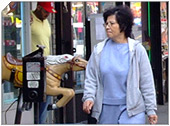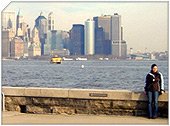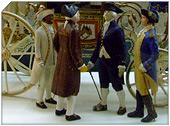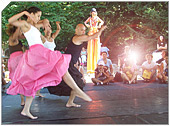Ocean Parkway , Brooklyn, New York City
|
Getting Started
Index
NYC Neighborhoods
Manhattan
Brooklyn
Queens
Bronx
Staten Island
NYC Icons
Chrysler Building
Flatiron Building
Empire State Building
Safe NYC
NYPD
FDNY
NYC Weather
NYC Climate
NYC Weather Forecast
Winter Season
Spring Season
Summer Season
Fall Season
NYC History & Politics
New York City History
Tammany Hall and Politics
New York City Politicians
New York City Personalities
Culture of Gotham City
Culture of the city
Cultural diversity
City in popular culture
|
Ocean Parkway is a broad boulevard and associated neighborhood in the west central portion of the borough of Brooklyn in New York City.
Ocean Parkway extends over a distance of about six miles (120 city blocks), running almost north to south from Prospect Park to Coney Island and Brighton Beach. Many residents are Orthodox Jewish. The parkway runs roughly parallel to Coney Island Avenue, an important commercial avenue that is several blocks to the east. It consists of a central bidirectional avenue of seven lanes, the middle lane being for left turns or a painted median, two small parallel side streets, and several medians with trees, benches, and pedestrian paths. There is also a bike path. The parkway is New York State Reference Route 908H, although this is not signed.
History
Frederick Law Olmsted and Calvert Vaux (who were also responsible for Central Park, Prospect Park, and the Eastern Parkway) suggested the Ocean Parkway to Brooklyn park commissioners in reports prepared during the 1860s. They drew up a plan together for the parkway, inspired by boulevards in Berlin and Paris (such as the present avenue Foch). In 1868 the land was acquired by the City of Brooklyn; work began in 1874 and was completed in 1880. The resulting parkway was similar to the Eastern Parkway, with a central roadway, a grassy median and pedestrian path, and a commercial road, with a width of 210 feet (64 meters). Trees, playing tables, and benches lined the pedestrian path and boulevard. The parkway began at Park Circle (now known as Machate Circle after Police Officer Robert Machate),at the southern entrance of Prospect Park), and passed through Windsor Terrace, Parkville, and other neighborhoods; and as time passed, new neighborhoods (such as Kensington) were built along its route. The Prospect Expressway, built in the 1950s, replaced the northernmost half-mile of the parkway, and in 1975 the parkway was designated a landmark by the city to prevent any additional alterations.
The pedestrian path was split in 1894 to create the first bike path in the United States. Around 1900, homes were constructed along the perimeter of the parkway, and during World War I, many mansions were built. Buyers came to Ocean Parkway from Bedford-Stuyvesant, Brooklyn Heights, and Bushwick. In the 1920s, apartment complexes and one- and two-family homes were constructed; the northernmost portion of the parkway became the site of luxurious, elevator-equipped apartment buildings.
Apartments began to replace older homes in the vicinity of the parkway after World War II.
Horse racing took place on the parkway until 1908, when a ban on open betting took effect. Until the parkway zoning was changed and restoration was carried out in the 1970s, bridle paths existed as well.
|
New York City Search
Quick NYC
|
|
|
 How safe is New York City?
How safe is New York City? Contrary to popular belief, the City consistantly ranks in the top ten safest large cities in the United States. The NYPD is the largest municipal police force in the world and has it's own Movie/TV Unit. |

New York has a humid continental climate resulting from prevailing wind patterns that bring cool air from the interior of the North American continent. New York winters are typically cold with moderate snowfall.  New York Weather Forecast New York Weather Forecast |

New York's two key demographic features are its density and diversity. The New York City metropolitan area is home to the largest Jewish community outside Israel. It is also home to nearly a quarter of the nation's South Asians, and the largest African American community of any city in the country.  Ethnic composition Ethnic composition |

New York Newspapers
 
|



 New York Weather Forecast
New York Weather Forecast
 Ethnic composition
Ethnic composition


















